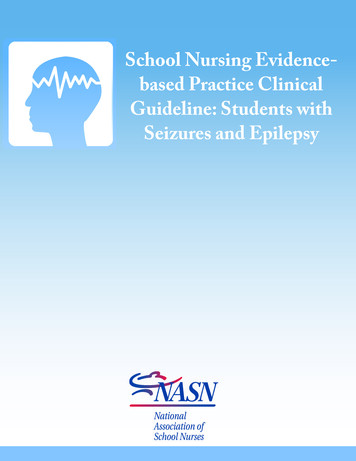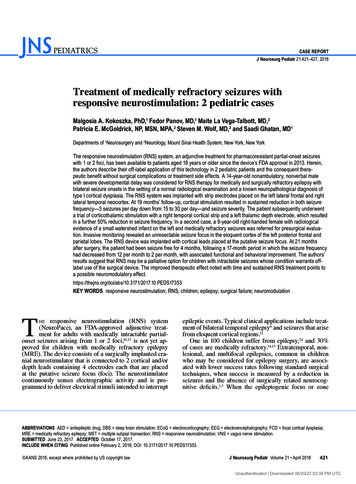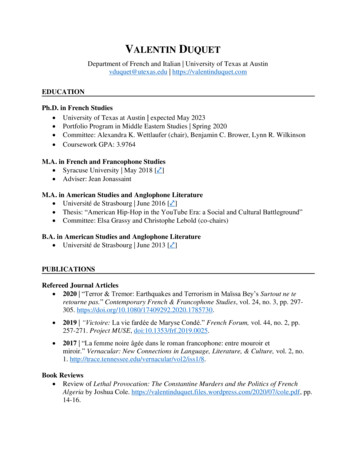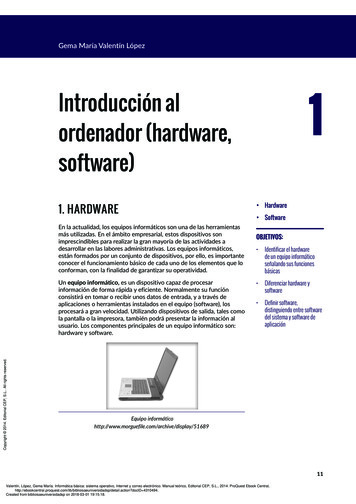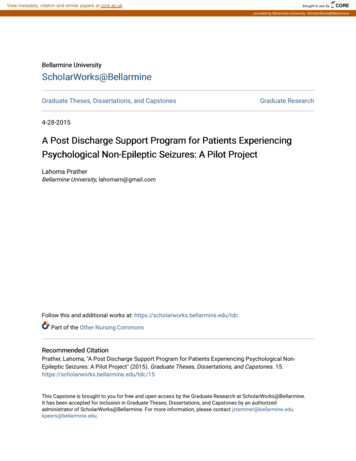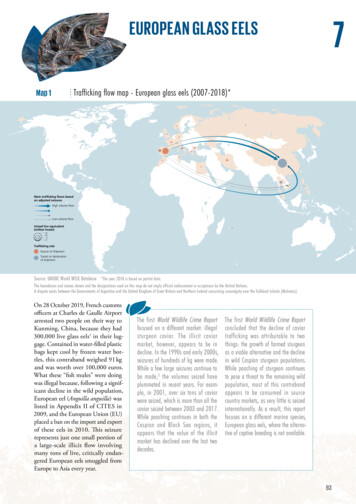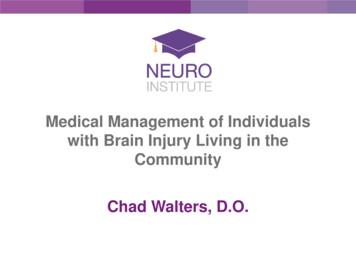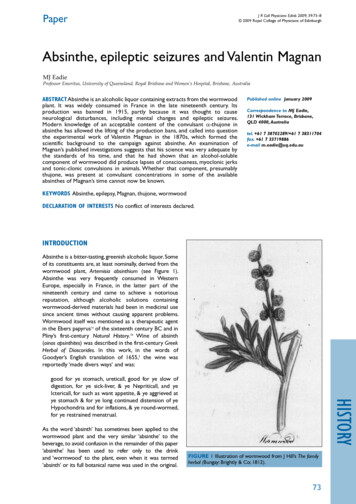
Transcription
PaperJ R Coll Physicians Edinb 2009; 39:73–8 2009 Royal College of Physicians of EdinburghAbsinthe, epileptic seizures and Valentin MagnanMJ EadieProfessor Emeritus, University of Queensland, Royal Brisbane and Women’s Hospital, Brisbane, AustraliaABSTRACT Absinthe is an alcoholic liquor containing extracts from the wormwoodplant. It was widely consumed in France in the late nineteenth century. Itsproduction was banned in 1915, partly because it was thought to causeneurological disturbances, including mental changes and epileptic seizures.Modern knowledge of an acceptable content of the convulsant a-thujone inabsinthe has allowed the lifting of the production bans, and called into questionthe experimental work of Valentin Magnan in the 1870s, which formed thescientific background to the campaign against absinthe. An examination ofMagnan’s published investigations suggests that his science was very adequate bythe standards of his time, and that he had shown that an alcohol-solublecomponent of wormwood did produce lapses of consciousness, myoclonic jerksand tonic-clonic convulsions in animals. Whether that component, presumablythujone, was present at convulsant concentrations in some of the availableabsinthes of Magnan’s time cannot now be known.Published online January 2009Correspondence to MJ Eadie,131 Wickham Terrace, Brisbane,QLD 4000, Australiatel. 61 7 38702289/ 61 7 38311704fax. 61 7 33719886e-mail m.eadie@uq.edu.auKeywords Absinthe, epilepsy, Magnan, thujone, wormwoodDeclaration of Interests No conflict of interests declared.introductionAbsinthe is a bitter-tasting, greenish alcoholic liquor. Someof its constituents are, at least nominally, derived from thewormwood plant, Artemisia absinthium (see Figure 1).Absinthe was very frequently consumed in WesternEurope, especially in France, in the latter part of thenineteenth century and came to achieve a notoriousreputation, although alcoholic solutions containingwormwood-derived materials had been in medicinal usesince ancient times without causing apparent problems.Wormwood itself was mentioned as a therapeutic agentin the Ebers papyrus1a of the sixteenth century BC and inPliny’s first-century Natural History.1b Wine of absinth(oinos apsinthites) was described in the first-century GreekHerbal of Dioscorides. In this work, in the words ofGoodyer’s English translation of 1655,2 the wine wasreportedly ‘made divers ways’ and was:As the word ‘absinth’ has sometimes been applied to thewormwood plant and the very similar ‘absinthe’ to thebeverage, to avoid confusion in the remainder of this paper‘absinthe’ has been used to refer only to the drinkand ‘wormwood’ to the plant, even when it was termed‘absinth’ or its full botanical name was used in the original.historygood for ye stomach, ureticall, good for ye slow ofdigestion, for ye sick-liver, & ye Nepriticall, and yeIctericall, for such as want appetite, & ye aggrieved atye stomach & for ye long continued distension of yeHypochondria and for inflations, & ye round-wormed,for ye restrained menstrual.Figure 1 Illustration of wormwood from J Hill’s The familyherbal (Bungay: Brightly & Co; 1812).73
historyMJ EadieThe absinthe available for human consumption in thepast two centuries, with its high concentration of ethylalcohol (45–75%), was developed from a formula thatoriginated in Switzerland late in the eighteenth century.3,4Classically, the beverage was made by distilling analcoholic extract of the dried above-ground parts of thewormwood plant. Further quantities of materialsobtained from wormwood and various other herbs(most commonly anise and fennel) were then added toa particular fraction of the distillate. The green colourfinally obtained was due to extracted chlorophyll.As the years passed, many modifications of the originalmethod were devised in making marketed absinthes.Various additional herbal materials and dyes weresometimes added to provide a satisfactory colour, as wellas certain chemicals to achieve other desirable visual andgustatory properties. The alcohol concentration indifferent absinthes varied, although it was always highenough to keep any added plant-derived oils in solution.At times, it seems that some commercial absinthescontained no material that originated from wormwood.5By the mid-nineteenth century, absinthe had become afavourite aperitif of the French middle classes. Elaboraterituals were often involved in its preparation preliminaryto intake. In brief, before drinking, the strongly alcoholicsolution was slowly diluted with water containingdissolved sugar (to counter the bitterness of theabsinthe) until the mixture became cloudy as the waterinsoluble herbal oils began to separate from solution.In the wake of the widespread infestation of the Frenchvineyards with Phylloxera in 1864, there was a shortage ofboth wine and grape-derived alcohol. Absinthes thenbegan to be made with cheaper, industrially producedethyl alcohol. It was soon realised that such absinthe hadbecome the cheapest source of drinkable alcohol generallyavailable in France. As a result, absinthe rapidly becamethe most popular form of alcoholic beverage drunk by thelower classes. It was also favoured by many French literaryand artistic figures of the time, including Charles Baudelaire,Arthur Rimbaud, Emile Zola, Paul Gauguin and Henri deToulouse-Lautrec, as well as by artists and writers fromother countries, such as Edgar Allan Poe and Oscar Wilde.The mental disturbances of Vincent van Gogh have beenattributed to his excessive intake of absinthe.5By the end of the nineteenth century, absinthe had cometo be regarded as a significant cause of mental illness andepileptic seizures. The existence of a syndrome,absinthism, involving substance dependence, hallucinations, epileptic seizures and mental deterioration,was postulated. As a result, absinthe production wasbanned in France in 1915, and in various other WesternEuropean countries and in the United States between1905 and 1923. The bans continued until recent times inthe European Union and still exist in the US.74With the advent in recent years of sensitive and specificanalytical methods, it became possible to investigate thecomposition of various absinthes and, in particular, tomeasure their contents of the chemical thujone, whichwas thought responsible for the alleged neurotoxicity ofabsinthe. The European Commission in 2003 specifiedwhat it considered safe contents of thujone for variousstrengths of alcoholic beverage.6 This knowledgepermitted the lifting of the ban on absinthe productionin Western European countries.An awareness of a reputedly safe thujone concentrationin alcoholic beverages and the widened commercialavailability of absinthe have resurrected the question ofwhether late nineteenth-century absinthes reallypossessed any toxicity beyond that attributable to theirhigh alcohol concentrations.7,8 Padosch et al.4 andLachenmeier et al.9 concluded that, purely on the basisof thujone content, it would seem unlikely that absinthemade according to the original Swiss recipe wouldhave carried any major risk of neurotoxicity. As a consequence of this information, present-day writers10,11have sometimes criticised the scientific work andinterpretations of Valentin Magnan, whose laboratoryand clinical studies in the 1870s and subsequent advocacyplayed a significant part in the banning of absintheproduction in France nearly a century ago.In fairness to Magnan, it is now impossible to knowwhether the actual compositions of the various absinthesthat were available in France in his day were as modernday analytical chemistry suggests they should have been.Consequently, little additional light can be thrown on thejustification of Magnan’s assessment of the neurotoxicmenace of the absinthe of his time. Rather, the presentpaper explores the adequacy of Magnan’s investigationalscience in relation to the clinical issue of absinthe intake,its neurotoxicity and potential for producing epilepticseizures, and the contributions to the understanding ofepileptic seizure mechanisms that emanated fromMagnan’s investigations.Valentin Magnan’s CareerValentin Jacques Joseph Magnan was born at Perpignan,in France, in 1835.11,12 He studied medicine at Montpellierand then worked at hospitals in Lyon before competingsuccessfully in 1863 for an internship in Paris at theBicêtre Hospital under Louis Marcé and at the SalpêtrièreHospital under Jean Pierre Falret. In 1867 he came to theattention of influential figures in Paris when he treatedthe Prince Imperial, the son of Louis Napoléon. Soonafterwards he was appointed to be in charge of theAdmissions Office of the newly opened Sainte-AnneAsylum in Paris. All instances of mental illness thatcame to the attention of the Paris police were assessedinitially at this institution, and their more definitivemanagement was then organised. Magnan occupied thisJ R Coll Physicians Edinb 2009; 39:73–8 2009 RCPE
Absinthe, seizures and Valentin Magnaninfluential appointment for the remainder of hisprofessional career, retiring in 1912 and dying four yearslater. Although passed over in 1877 for the newlycreated Chair in Mental Disease in Paris, Magnan becameperhaps the most considerable figure in Frenchpsychiatry of his time, and the leader of one of itsmain schools of thought.Magnan’s professional achievements lay in three mainareas. In the late 1860s and the following decade heworked on the clinical consequences of alcohol abuse, inparticular of absinthe, and carried out animal experimentation relevant to these matters. He continued tocampaign against these abuses throughout the remainderof his life, but from the 1880s his interest expanded intothe classification of mental illness.12 He believed thatsuch illness should be categorised on the basis of its lifelong course and took up Bénédict Augustin Morel’s ideathat was so influential in French psychiatry, viz that suchillness was a moral degeneration.Magnan modified this interpretation, minimised itsreligious connotations and formed the view that therewere two types of degeneracy, one being inherited andthe other a chronic delusional insanity. Either type, butparticularly the latter, could develop into dementia.Magnan’s ideas were not universally accepted in Frenchpsychiatric circles.13 The subsequent controversies in thenational professional community resulted in aconsiderable delay to its acceptance of Emil Kraepelin’ssubdivision of psychotic illness (apart from generalparalysis of the insane) into manic-depressive diseaseand dementia praecox (later called schizophrenia).Towards the end of his professional activities and in hisretirement, Magnan was before his time in advocatingless enforced restriction of the mentally ill and theabandoning of straitjackets and other forms of restraint,and employing an open-ward policy with the earlyreturn of the sufferer into the community.Magnan’s research relating to absintheJ R Coll Physicians Edinb 2009; 39:73–8 2009 RCPEcaused epileptiform clonic convulsions, incontinence,stertorous respirations and death.An association between absinthe and convulsing hadalso been noted by the great French clinician ArmandTrousseau.16 Trousseau described the case of Mr W.,aged 38 in 1861, who when aged 25 ‘had well-markedepileptic fits, probably due to his excessive use ofabsinthe, for the fits disappeared after two years, and onhis giving up drinking absinthe’. The time factorssuggest that somewhere between 1850 and 1861Trousseau had recognised the association betweenabsinthe and seizures, so that he probably had priorityover the Bicêtre alienists in observing the association.Magnan’s own work in the area began in 1864,17 while hewas collaborating with Marcé. There were majorpublications from Magnan in 1869,18 a short monograph,Étude expérimentale et clinique sur l’alcoolisme19 (Figure 2),and a long paper20 in 1871 and a major monograph,De l’alcoolisme, de diverses formes de délire alcoolique et75historyMagnan was not the first to note a possible associationbetween excessive absinthe intake and the occurrence ofepileptic seizures and mental disturbance. He himself gavecredit for this to Auguste Motet at the Bicêtre,who in 1859 described instances of the association in adoctoral thesis submitted to the University of Paris.14Marcé, whom Magnan referred to as his ‘master’ at theBicêtre, had also reported the matter in a paper publishedin 1864.15 Marcé claimed absinthe possessed a specialaction beyond that of its alcohol content because,unlike simple alcohol intoxication, it rapidly producedstupor, hebetude (dullness of mind), terrifying hallucinationsand intellectual enfeeblement. He found that giving dogs2–3 g of wormwood essence produced trembling, mentaldullness and stupor, and led to the appearances ofprofound terror. Doses of 3–8 g of wormwood essenceFigure 2 The title page of Valentin Magnan’s 1871monograph on alcoholism and absinthic epilepsy.
historyMJ Eadiede leur traitment, in 1874,21 soon afterwards translatedinto English by Greenfield. Magnan also summarised hiswork in an English language paper which appeared inThe Lancet in 1874.22 He reported some of his earlierinvestigations on more than one occasion in his laterpublications. It seems unlikely that all of his experimentalobservations were published under his name since, whilehe mentioned that he had worked on dogs, cats, rabbits,guinea pigs and various birds,18 nearly all his experimentaldetails traced in print refer to studies carried out indogs. However, Robert Amory, who had earliercollaborated with Magnan, published some of his ownoriginal data, some joint work with Magnan includingstudies in non-canine species and some of Magnan’searlier work in North American medical literature.23In 1864, Magnan described a 30-year-old male who onthree separate occasions experienced vertiges (a termthen used for brief non-convulsive epileptic seizureswith impaired consciousness) and convulsive epilepticseizures at times when he was drinking absinthe, butnever when he abstained.17 Magnan stated that he hadencountered further instances of the association. Fromthe experimental design of his laboratory studies, itseems that Magnan was aware of the need todistinguish between the roles of alcohol and of otherabsinthe constituents in provoking epileptic seizures andother manifestations of neurotoxicity.18 He took theprecaution of always using wormwood oil from the samereputable manufacturer, and reported that alcoholicextracts of the following components of contemporaryabsinthes, given individually to dogs, even in largeintragastric doses, did not evoke seizures: essences ofanise (aniseed, Pimpinella anisum), badian (star-anise,Illicium anisatum) and angélique (Angelica archangelica);sweet flag (Calamus aromaticus), origen (oregano,Origanum vulgare), menthe (mint, Lamiaceae species) andmélisse (Melissa officinalis).19 Nor did alcohol itself.In contrast, 5 g of wormwood essence caused tonicclonic seizures and ‘hallucinations’ (i.e. behaviour as if theanimal was hallucinating), whereas lower doses causedvertiges and brief secousses (i.e. myoclonic jerks or jolts)involving the head and anterior parts of the body. On theother hand, chronic daily alcohol intake in increasingquantities in a dog produced widespread tremblings,paraplegia (i.e. hind limb weakness – alcoholic peripheralneuropathy was not then widely known) and coma, allincreasing after each intake of alcohol. The combinationof alcohol and essence of wormwood in another dogresulted in tremblings, alcoholic paraplegia andepileptiform seizures.By present-day standards, the numbers of dogs Magnanstudied would appear inadequate to permit well-basedconclusions, although it is not clear whether Magnan hadadditional supporting data and had simply publishedaccounts of representative experiments. If the latter was76the case, Magnan had provided reasonable evidence thatthe components of wormwood essence that should havebeen present in absinthe could have conferred convulsantand other neurotoxic properties on the beverage. Hisstudies also suggested that the pattern of absinthe-relatedepileptic events to be expected in humans would involvelapses in consciousness (absences, petit mal), myoclonicjerks and generalised tonic-clonic epileptic seizures, i.e.phenomena resembling those of a primary generalisedepilepsy of juvenile myoclonic type.Was this the pattern of the reported seizures associatedwith human absinthe abuse? Magnan described only thepresence of generalised tonic-clonic seizures in several ofhis human cases. However, in Case XI in Greenfield’stranslation of Magnan,21 the continued intake of absinthewas associated with ‘sudden faintings’, increasing ‘absences’or faints and epileptic seizures. In Case XII, a 42-year-oldmale who drank absinthe and brandy to excess oversome years experienced attacks of ‘vertigo’ (probably atranslation into English of vertiges, i.e. minor non-convulsiveepileptic seizures), muscle twitchings and then fits. Unlessthese two of the five human cases reported in Magnan’smonograph were instances of causally unrelated primarygeneralised epilepsy, it seems that absinthe in humansprovoked epileptic phenomena of a pattern similar to thatwhich occured in animals given essence of wormwood.At the time of Magnan’s studies, Herpin24 had very recentlypublished the first clear description of what was tobecome known as the juvenile myoclonic type of primarygeneralised epilepsy. Therefore Magnan may not haveappreciated the importance of the lapses and jerkings thathe saw in his patient.Magnan carried out additional work on epileptic seizuresprovoked by wormwood extract that was not directlyrelevant to the absinthe-epilepsy question. For instance,in two pigeons he showed that seizures induced bywormwood essence continued after the cerebralhemispheres had been removed surgically.19 In a dog keptalive by artificial respiration after its neuraxis had beensevered at the cervico-medullary junction, he reportedthat intravenous wormwood essence caused jerking inthe upper part of the animal’s body, followed by clonicand then generalised convulsing as the wormwood dosewas increased. In 1873 he used an ophthalmoscope tolook for retinal vessel changes during wormwoodinduced seizures in a dog, and in another animal made atrepan hole in the skull to inspect the superficial cerebralarteries during wormwood-induced seizures.20Presumably Magnan was seeking evidence of the cerebralcirculatory alterations that were at the time believedto underlie epileptogenesis, although he seemed to leaveit to his readers to deduce the rationales of hisexperiments, and to interpret them. Some of Magnan’sobservations had pharmacokinetic implications, which heagain did not make explicit. In 1871 he reported that ifJ R Coll Physicians Edinb 2009; 39:73–8 2009 RCPE
Absinthe, seizures and Valentin Magnana-thujoneb-thujoneFigure 3 Structural formulae of thujone enantiomers.essence of wormwood was given to a dog together withalcohol, the expected convulsion was deferred for severalhours, even though the smell of absinthe appeared rapidlyon the animal’s breath.19 Did the alcohol delay theabsorption of the convulsant agent in absinthe or slow itsentry into the brain? Magnan provided an answer when asecond dog was given alcohol by mouth. In this animal,subsequent intravenous essence of woodworm producedconvulsing at the expected time. Therefore alcoholprobably delayed the absorption of the convulsantcomponent present in wormwood essence.The neurotoxic agent in wormwoodMagnan’s seemingly well-designed investigations made itclear that if absinthe possessed convulsant and otherforms of neurotoxic activity, that activity probably residedin its wormwood-derived components. With advances inanalytical chemistry it has been shown that wormwoodoil contains thujone, a known convulsant, and that thebitter taste of wormwood derives at least in part fromthe content of absinthin.9 Other terpene lactones are alsopresent. Thujone exists in two stereoisomeric forms(Figure 3), both of which possess convulsant properties.Some 70–90% of the total thujone in wormwood oil is inthe form of the b-enantiomer,5 but the main biologicalactivity resides in the a-enantiomer.25J R Coll Physicians Edinb 2009; 39:73–8 2009 RCPETaken together, these facts make it probable thata-thujone in the wormwood-derived component ofabsinthe was responsible for the association betweenabsinthe intake and epileptic seizures that was noticedby Magnan and his contemporaries. While safeconcentrations for thujone in alcoholic beverages havenow been determined, and recent studies have shownthat present-day absinthes prepared according to theoriginal Swiss recipe should not have had dangerousthujone concentrations, it remains possible that some ofthe absinthes drunk by Magnan’s patients may have hadhigher thujone concentrations. It is also possible thatsome of Magnan’s patients may have had a geneticpredisposition to juvenile myoclonic epilepsy, eventhough they had no past history of clinical seizures. Suchpersons might be expected to be unusually vulnerable tothe epileptogenic consequences of thujone-inducedGABAA receptor blockade.DISCUSSIONModern scientific evidence lends some support to thebelief of Magnan and some of his Parisian contemporariesthat the absinthe of their time possessed the capacity tocause convulsing and other neurotoxic manifestations.Whether its convulsant principle (a-thujone), as distinctfrom alcohol itself, explained the reported hallucinatoryand other psychological effects of excess absinthe intakeis less clear. However, there can be little doubt thatMagnan22 was being far-sighted when, in The Lancet, hewrote that the ‘essence of absinthe is a valuable agentfor the study of the mechanism of epilepsy.’Magnan himself used absinthe for this purpose, asdescribed above, and it was employed by otherinvestigators in the late nineteenth century to provokeepileptic seizures in experimental animals and then tostudy the effects of various cerebral manipulations onthe induced seizure phenomena.31–35 In the early decadesof the twentieth century, Howard Florey36 used it in hisinvestigations on the cerebral circulation carried out inCharles Sherrington’s laboratory in Oxford.77historya-Thujone is a GABAA receptor non-competitiveantagonist.25 Because its molecular structure resemblesthat of part of the cannabinoid molecule, it was at one timesuggested that a cannabinoid-type action might beresponsible for the hallucinatory and other psychologicaleffects claimed for absinthe.26 More recent evidence doesnot support this interpretation.27 Thujone inducescytochrome P450 activity,25 and is porphyrinogenic.28 Becauseof this latter effect it was suggested that thujone in absinthemay have caused Vincent van Gogh’s hallucinations since healso happened to suffer from unrecognised porphyria.28Other GABAA receptor antagonists such as picrotoxininand pentylenetetrazole (Metrazole)29 cause epilepticseizures in experimental animals and in humans, and theinduced seizure pattern resembles that of a primarygeneralised epilepsy, with its interruptions ofconsciousness, multiple myoclonic jerks and, at higherdosages, generalised tonic-clonic convulsing. For a timepentylenetetrazole seizures were considered a modelfor human absence epilepsy, although the seizuresproduced resembled myoclonic jerks more closelythan absence ones. It is also known that theoxazolidinedione family of drugs, effective in humansagainst petit mal absence seizures, prevents thujoneinduced seizures in animals.30
historyMJ EadieWormwood, as suggested by its name, has been aremedy for intestinal worms since ancient times,although herbals such as those of Diascorides2 andCulpeper37 were not particularly enthusiastic concerningits efficacy. At least from the Middle Ages onwards,intestinal worms were commonly regarded as a cause ofepileptic seizures, particularly in children (for exampleby Bernard of Gordon,38 early in the fourteenth century).Although some nineteenth-century authors were moresceptical,39,40 the great neurological figure Sir WilliamGowers held as late as 1881 that:Acute convulsions frequently result from the irritationof various forms of intestinal worms in children andsometimes in adults. Usually, however, they ceasewhen the worms are expelled.41Because of the generations-old popular perceptionthat there was a relationship between intestinal wormsand convulsions in children and the continuing medicalendorsement of this idea, it seems possible that the useof wormwood (with its content of convulsant thujone) totreat intestinal worms when their presence was recognisedmay have sometimes contributed to the occurrence ofthe convulsions it was intended to prevent.References1a The Papyrus Ebers.The greatest Egyptian medical document. Translatedby Ebbell B. Copenhagen: Levin & Munksgaard; I937.1b Pliny. Natural history. Translated by Jones WHS. London andCambridge, Mass: Heinemann and Harvard University Press; 1951.2 Günther RT, editor. The Greek herbal of Dioscorides. New York:Hafner; 1959.3 Adams J. Hideous absinthe. A history of the devil in a bottle. Londonand New York: Tauris; 2004.4 Padosch SA, Lachenmeier DW, Kröner LU. Absinthism: a fictitious19th century syndrome with present impact. Subst Abuse Treat PrevPolicy 2006; 1(1):14.5 Lachenmeier DW, Walch SG, Padosch SA et al. Absinthe – areview. Crit Rev Food Sci Nutr 2006; 46(5):365–77.6 European Commission. Opinion of the Scientific Committee on Foodon thujone. Brussels: European Commission; 2003. Available from:http://ec.europa.eu/food/fs/sc/scf/out162 en.pdf7 Anonymous. Absinthe and alcohol. Lancet 1869; i:334.8 Strang J, Arnold WN, Peters T. Absinthe: what’s your poison?Though absinthe is intriguing, it is alcohol in general we shouldworry about. BMJ 1999; 319(7225):1590–2.9 Lachenmeier DW, Emmert J, Kuballa T et al. Thujone – cause ofabsinthism? Forensic Sci Int 2006; 158(1):1–8.10 Hutton I. Myth, reality and absinthe. Curr Drug Discov 2002; 9:62–4.11 Luauté J-P. L’absinthisme: la faute du docteur Magnan. L’évolutionpsychiatrique 2007; 72:515–30.12 Dowbiggin I. Back to the future: Valentin Magnan, Frenchpsychiatry, and the classification of mental disease, 1885–1925.Soc Hist Med 1996; 9(3):353–408.13 Shorter E. A history of psychiatry. New York: Wiley; 1997.14 Motet A. Considerations générales sur l’alcoolisme, et plusparticularèment des effets toxiques products sur l’homme par laliqueur d’absinthe [Thesis]. Paris: University of Paris; 1859.15 Marcé M. Sur l’action toxique de l’essence d’absinthe. ComptesRendus Hebdomadaires des Seances de l’Acadamie des Sciences 1864;58:628–9.16 Trousseau A. Lectures on clinical medicine. Vol. 1. Translated by Basire V.London: New Sydenham Society; 1868.17 Magnan V. Accidents determines pat l’abus de la liqueur d’absinthe.L’union médicale 1864; 92:227–32, 94:257–62.18 Magnan V. Epilepsie alcoolique; action spéciale de l’absinthe:épilepsie absinthique. C R Biol 1869; 20:156–61.19 Magnan V. Étude expérimentale et clinique sur l’alcoolisme. Alcool etabsinthe. Epilepsie absinthique. Paris: Renou et Maulde; 1871.20 Magnan V. Recherche de physiologie pathologique avec l’alcool etl’essence d’absinthe. Arch Physiol Norm Patho 1873; 5:115–42.21 Magnan V. De l’alcoolisme, des diverses formes de délire alcoolique etde leur traitment. Paris: Delahaye; 1874.7822 Magnan V. On the comparative action of alcohol and absinthe.Lancet 1874; 2:410–2.23 Amory R. Experiments and observations on absinth and absinthism.Boston Med Surg J 1868; 1:68–71, 83–5.24 Herpin T. Des accès incomplets d’épilepsie. Paris: Ballière; 1867.25 Höld KM, Sirisoma NS, Ikeda T et al. a-Thujone (the activecomponent of absinthe): g-aminobutyric acid type A receptormodulation and metabolic detoxication. Proc Nat Acad Sci 2000;97:3826–31.26 Del Castillo J, Anderson M, Rubottom GM. Marijuana, absintheand the central nervous system. Nature 1975; 253:365–6.27 Meschler JP, Howlett AC. Thujone exhibits low affinity forcannabinoid receptors but fails to evoke cannabimimetic responses.Pharmacol Biochem Behav 1999; 62: 473–80.28 Bonkovsky HL, Cable EE, Cable JW et al. Porphyrogenic propertiesof the terpenes camphor, pinene, and thujone. Biochem Pharmacol1992; 43:2359–68.29 Olsen RW. Absinthe and the gamma-aminobutyric acid receptors.Proc Nat Acad Sci 2000; 97:4417–8.30 Grollman A, Grollman EF. Pharmacology and therapeutics. 6th ed.Philadelphia: Lea & Febiger; 1965.31 Francois-Frank CE, Pitres A. Recherches expérimentales etcritiques sur les convulsions épileptiformes d’origine corticale.Arch Physiol Norm Pathol 1883: 15:1–40, 101–44.32 Horsley V. Production of artificial epilepsy in guinea-pigs. BMJ 1886;2:976–7.33 Dupuy E. The rolandic area cortex. Brain 1892; 15:190–214.34 Ott I. The seat of absinthic epilepsy. J Nerv Ment Dis 1892;19:696–8.35 Boyce R. A contribution to the study of descending degenerationsin the brain and spinal cord, and of the seat of origin and pathsof conduction of the fits of absinthe epilepsy. Phil Trans1895;189:321–81.36 Florey H. Microscopical observations on the circulation of theblood in the cerebral cortex. Brain 1925; 48:43–64.37 Culpeper N. The complete herbal and the English physician enlarged.Ware: Wordsworth Editions; 1995 (Originally published 1653).38 Lennox WG. Bernard of Gordon on epilepsy. Ann Med Hist 1941;3:372–83.39 North J. Practical observations on the convulsions of infants. London:Burgess & Hill; 1826.40 Osler W. The principles and practice of medicine. New York:Appleton & Co.;1892.41 Gowers WR. Epilepsy and other chronic convulsive diseases: theircauses, symptoms and treatment. London: Churchill; 1881.42 Hill J. The family herbal. Bungay: Brightly & Co; 1812.J R Coll Physicians Edinb 2009; 39:73–8 2009 RCPE
absinthe, for the fits disappeared after two years, and on his giving up drinking absinthe'. The time factors suggest that somewhere between 1850 and 1861 Trousseau had recognised the association between absinthe and seizures, so that he probably had priority over the Bicêtre alienists in observing the association.



